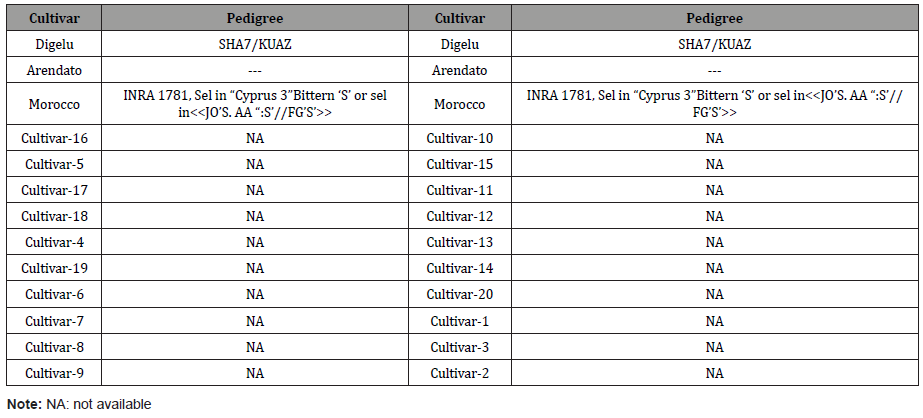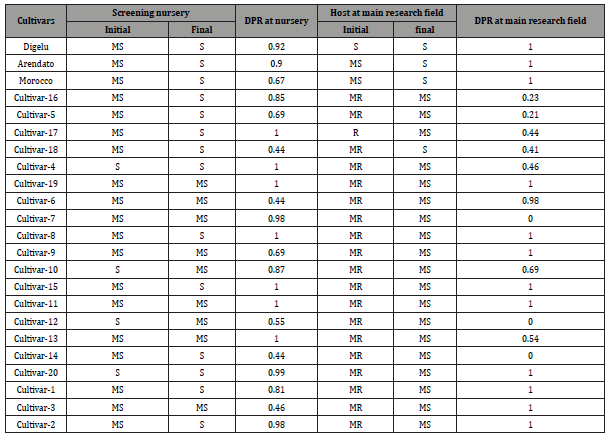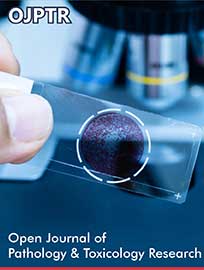 Research Article
Research Article
Evaluation of Selected Durum Wheat (Triticum Turgidum Subsp. Durum) Local Cultivars for their Reaction to Leaf Rust (Puccinia Triticina)
Asnakew Ashagre Z*
Ethiopian Institute of Agricultural research, Debre Zeit Agricultural research Center, Ethiopia
Asnakew Ashagre Z, Ethiopian Institute of Agricultural research, Debre Zeit Agricultural research Center, Ethiopia
Received Date:May 31, 2022; Published Date: June 14, 2022
Abstract
Leaf rust, caused by Puccinia triticina, is one that economically important disease of wheat worldwide. This disease causes severe yield losses ranging from 30 to 50%. In Ethiopia; leaf rust caused by the pathogen Puccinia triticina is one of the important diseases of wheat and yield loss due to this disease has reached up to 75%. The experiment was conducted on wheat disease screening nursery and main research field at Debre Zeit Agricultural Research Center in 2018/19 using 20 local cultivars collected from chefe donsa district which is known availability of local cultivars in the area. Digelu, Arendato and Morocco seeds were sown as susceptible standard checks. Cultivars such as (16, 4, 7, 12, 14, 20, 1, 3 and 2) have shown lesser TRS with resistance types at both locations during the life of the experiment. In the same way Cultivar such as (12 and 14) has shown equal low disease progress rate at screening nursery and main research field. Among tested 20 cultivars such as (19, 6, 7, 11, 12, 13, 3, 2) have revealed less IC value with resistance character than standard check at both locations. It is important to search local variants and cultivars for available gene to tackle the identified and newly evolving races. The available major and minor gene should be identified to know the specific resistance gene. These generate an opportunity to improve durum wheat variety and cultivars resistance against leaf rust and future manipulation in wheat improvement program after confirmatory study.
Keywords: Leaf-rust; Cultivars; TRS; DPR; Infection coefficient
Introduction
Rusts are important pathogens of angiosperms and gymnosperms including cereal crops and forest trees. With respect to cereals, rust fungi are among the most important pathogens. Cereal rusts are heteroecious and macrocyclic requiring two taxonomically unrelated hosts to complete a five spore stage life cycle. Cereal rust fungi are highly variable for virulence and molecular polymorphism. Leaf rust, caused by Puccinia triticina is the most common rust of wheat on a worldwide basis. Modernization of agriculture is a key to Africa continent future to meet the need of population food security. Crop production is a major contributor to GDP, accounting for approximately 28% from the sub-sectors of agriculture [1]. Ce real crops such as Teff, wheat, maize, sorghum and barley are the most important food crop which ensures daily food. Hence, cereal production and marketing are the means of livelihood strategy for millions of smallholder households in Ethiopia. Wheat is the third major cereal crop produced in Ethiopia and taken as strategic crop [2]. The productivity of wheat is less in Ethiopia which is highly constrained by rusts that can cause significant yield losses [3]. The rust pathogens are among the most important pathogens causing a continuous threat to wheat production and have been reported to cause a vast number of losses in different areas, years and environments favoring disease epidemics [4,5]. Cereal rusts are heteroe- cious and macrocyclic requiring two taxonomically unrelated hosts to complete a five-spore stage life cycle. Cereal rust fungi are highly variable for virulence and molecular polymorphism. Wheat leaf rust, caused by Puccinia triticina, is one of the three wheat rusts and is economically important disease of wheat worldwide [6]. Rusts are important pathogens of angiosperms and gymnosperms including cereal crops and forest trees. Leaf rust is one of the three wheat rusts and is economically important disease of wheat worldwide. It is caused by Puccinia triticina is the most common rust of wheat on a worldwide basis [7]. Many of races of P. triticina vary for virulence to leaf rust resistance genes in wheat differential lines. This disease occurs in almost all wheat growing areas and causes severe yield losses ranging from 30 to 50% [8]. In Ethiopia; leaf rust caused by the pathogen Puccinia triticina is one of the important diseases of wheat and yield loss due to this disease has reached up to 75%. Adult Plant Resistance (APR) genes offer resilient resistance to rust diseases [9]. Stated that there is resistance gene in all wheat cultivars for Leaf Rust resistance. Therefore, the identification of new resistance sources to leaf rust is significant for breeding durable, rust-resistant wheat cultivars in combination with high and stable yield potential and other important traits [10]. It is important to through put capabilities allowing detection of whole-genome by genotyping system, scoring hundreds of polymorphic loci by sequence information and codominance with a large number of available markers [11]. Wheat varieties developed by the International Maize and Wheat Improvement Center (CIMMYT)’s Global Wheat Program is remained highly resistant to rusts in the world although the genetic basis of its resistance remains unknown. The objective of the research is to find a new resistance source of durum wheat for wheat leaf rust (Puccinia tritici). Responding to the severity of bread wheat rust epidemics, breeders have identified a source of durable, long-lasting resistance from within the plant itself, discovering the disease can be controlled by race- nonspecific APR genes.
Materials and Method
Planting materials and Sites Selection
total of 20 durum wheat cultivars collections from highland of highland area of east shewa zone at Gimbichu district. They were evaluated against leaf rust (Table 1). The experiment was conducted at two locations at screening nursery and main research field. The mixture of bread wheat cultivar Morocco, Digelu, and Arendato were used as susceptible check and spreader row which are known standard susceptible checks. The experiment was conducted following augmented design only checks were randomized. Recommended agronomic practices were applied to grow a healthy crop (Table 1).
Table 1: Terminal rust severity results for cultivars in respect to standard checks.

Leaf rust data collection
The leaf rust severity was recorded as percent of the rust infection according to the modified Cobb’s scale [12] and the host response scale to the infection type [13]. The disease data were converted to slow rusting parameters ACI, TRS, AUDPC [14] and DPR [15]. The data on disease severity and host reaction was combined to calculate the coefficient of infection (CI) by multiplying the severity value of 0.2, 0.4, 0.8, 1.0 for host response ratings R, MR, MS, S, respectively [16] (Table 2).
Table 2: Terminal rust severity results for cultivars in respect to standard checks.

Result and Discussion
Terminal rust severity (TRS)
TRS is important parameter for the evaluation leaf rust. During the experiment Digelu, Arendato and Morocco wheat variety were used as standard check. Digelu has shown 1% TRS with reaction of moderately susceptible at screening nursery which is not severely infected. In the other case Arendato has shown 40% TRS with the response of MS and S at screening nursery which is categorized as susceptible. Cultivars such as (16, 5, 17, 18, 4, 6, 7, 8, 9, 10, 15, 11, 13, 14, 20, and 1 and 2) at screening nursery have shown the same and greater value than standard checks susceptible reaction than other cultivars (Table 3). Conversely, cultivars such as (19, 12 and 3) has shown lesser TRS value with the value of 30, 25 and 15; respectively with MS reaction (Table 3). Conversely; cultivars (16, 4, 7, 12, 14, 20, 1, 3 and 2) has shown greater TRS value than susceptible standard checks and other cultivars (Table 3).
Table 3: Terminal rust severity (TRS) results for cultivars in respect to standard checks.

Disease progress rate (Rust progress rate) (DPR)
Disease progression rate used to show how fast the cultivars rust. The susceptible standard checks (Digelu, Arendato and Morocco) has 0.92, 0.90, 0.67 disease progress rate at screening nursery. Cultivars (such as 16, 5, 17, 4, 19, 7, 8, 9, 10, 15, 11, 13, 20, 1 and 2) have shown greatest DPR. While Cultivar such as (18, 6, 12, 14 and 3) has less DPR value of 0.44, 0.44, 0.55, 0.44 and 0.46, respectively. At main research field, the standard checks have reached the maximum Disease progress rate 1 (one) with final rust response of susceptible. Cultivars as (19, 6, 8, 9, 10, 15, 11, 20, 1, 3 and 2) have shown susceptible reaction (Table 4). While cultivar like (16, 5, 17, 18, 4, 7, 12, 13 and 14) has shown less DPR. With special case cultivar such as (7, 12 and 14) have revealed zero (0) value at main research field. Cultivar such as (12 and 14) has shown equal low disease progress rate at both locations (Table 4).
Table 4: Disease progress rate as results for cultivars in respect to standard checks.

Infection Coefficient (IC)
The data on average coefficient of infection (ACI) recorded during main rainy season2018/19. The leaf rust severity and average coefficient of infection (ACI) of 20 genotypes is listed in the (Table 5). Susceptible checks have revealed moderately susceptible (MS) to susceptible (S) reaction of ACI values. Among tested 20 cultivars such as (19, 6, 7, 11, 12, 13, 3, 2) have revealed less IC value with resistance character than standard check at both locations while the others has revealed IC value above susceptible checks reaction for tested races (Table 5). These resistance genotypes can be used as a potential source for breeding program in Ethiopia, while the other tested wheat genotypes were varied in their response to leaf rust. For tested susceptible cultivars including standard checks has showed some immune character this means. Thus, we cannot conclude if these genotypes were effective for other location or not by the results of this study (Table 5).
Table 5: Infection coefficient as results for cultivars in respect to standard checks.

Conclusion
The evaluation for slow rusting character was based on AIC, TRS, AUDPC and Disease Progress Rate. The cultivars have showed varying level of disease reaction against leaf rust under natural field at DZARC grouped by different category slow rusting character. Based on the study; it is important that continuously characterize and identification of resistance cultivars against newly evolving leaf rust races which requires attention. Use of slow rusting cultivars for breeding programs for variety improvement to replace the available and susceptible variety like cultivar-12 have better resistance against leaf rust and promising for variety improvement, and gene deployment. The available major and minor gene should be identified to know the specific resistance gene. These generate an opportunity to improve durum wheat variety and cultivars resistance against leaf rust and future manipulation in wheat improvement program after confirmatory study. Anywhere local cultivated durum wheat cultivars and cultivars are important to search the available gene for their resistance against the identified and newly evolving races is mandatory across all leaf rust important areas. The economic importance of finding and searching for resistance genes to leaf rust from old and new cultivars of wheat as a valuable tool has indicated by the Global Rust Initiative (2005).
Acknowledgment
I would like to gratefully thank Debre Zeit Agricultural Research Center who supports me by providing the budget.
Conflict of Interest
The author has not declared any conflict of interest on the paper.
References
- Duguma B, Tegegne A, Hegde BP (2012) Smallholder livestock production system in Dandi district, oromia Regional State, central Ethiopia. Global Veterinaria 8(5): 471-479.
- CSA (2019) Report on area and production of major crops (For private peasant holding, Meher Season Volume 1). Addis Ababa Ethiopia Central Statistical Agency.
- Marasas CN, Smale M, Singh RP (2002) The impact of agricultural maintenance research: the case of leaf rust resistance breeding in CIMMYT-related spring bread wheat. CD-ROM Proc Int Conf on Impacts of Agricultural Research and Development San Jose Costa Rica: 4-7.
- Pardey PG, Alston JM, Chan‐Kang C (2013) Public agricultural R and D over the past half century: an emerging new world order. Agricultural Economics 44(1): 103-113.
- Singh RP, Hodson DP, Jin Y, Lagudah ES, Ayliffe MA, et al. (2015) Emergence and spread of new races of wheat stem rust fungus: continued threat to food security and prospects of genetic control. Phytopathol 105(7): 872-884.
- Bolton MD, Kolmer JA, Garvin DF (2008) Wheat leaf rust caused by Puccinia triticina. Mol Plant Pathology 9(5): 563-575.
- James K (2013) Leaf Rust of Wheat: Pathogen Biology, Variation and Host Resistance. Forest Review 4: 70-84.
- McIntosh RA, Wellings CR, Park RF (1995) Wheat Rusts: An Atlas of Resistance Genes. East Melbourne CSIRO Publications.
- Li Z, Lan C, He Z, Singh RP, Rosewarne GM, et al. (2014) Overview and application of QTL for adult plant resistance to leaf rust and powdery mildew in wheat. Crop Sci (54): 1907-1925.
- Basnet BR, Singh RP, Ibrahim AMH, Herrera-Foessel SA, Huerta- Espino J, et al. (2014) Characterization of Yr54 and other genes associated with adult plant resistance to yellow rust and leaf rust incommon wheat Quaiu 3. Mol Breed 33: 385-399.
- Schouten HJ, Van de Weg WE, Carling J, Khan SA, McKay SJ, et al. (2012) Diversity arrays technology (DArT) markers inapple for genetic linkage maps. Mol Breed 29: 645-660.
- Peterson RF, Campbell AB, Hannah AE (1948) A diagrammatic scale for estimating rust intensity of leaves and stem of cereals. Can J Res Sect C 26: 496-500.
- Roelfs AP, Singh RP, Saari EE (1992) Rust Disease of Wheat: Concepts and Methods of Disease Management. CIMMYT Mexico DF, pp. 81.
- Campbell CL, Madden LV (1990) Introduction to plant disease epidemiology. New York John Wiley and Sons, pp. 532.
- Berger RD (1981) Comparison of the Gompertz and Logistic equation to describe plant disease progress. Phytopathol 71(7): 716-719.
- Pathan AK, Park RF (2006) Evaluation of seedling and adult plant resistance to leaf rust in European wheat cultivars. Euphytica 149: 327-342.
-
Asnakew Ashagre Z. Evaluation of Selected Durum Wheat (Triticum Turgidum Subsp. Durum) Local Cultivars for their Reaction to Leaf Rust (Puccinia Triticina). Open J Pathol Toxicol Res. 1(2): 2021. OJPTR.MS.ID.000508.
-
Angiosperms, Gymnosperms, Cereal crops, Rust fungi, Heteroecious, Macrocyclic, Molecular polymorphism, Favoring disease epidemics, Maximum Disease progress, Leaf-rust, Cultivars, TRS, DPR, Infection coefficient
-

This work is licensed under a Creative Commons Attribution-NonCommercial 4.0 International License.






